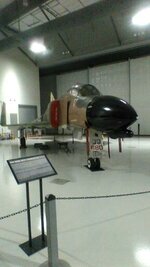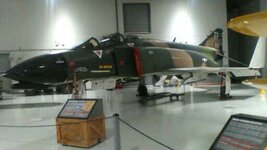Good shots!
Navigation
Install the app
How to install the app on iOS
Follow along with the video below to see how to install our site as a web app on your home screen.
Note: This feature may not be available in some browsers.
More options
You are using an out of date browser. It may not display this or other websites correctly.
You should upgrade or use an alternative browser.
You should upgrade or use an alternative browser.
Pictures of Cold War aircraft. (2 Viewers)
- Thread starter syscom3
- Start date
Ad: This forum contains affiliate links to products on Amazon and eBay. More information in Terms and rules
More options
Who Replied?More remains - the French Espadon...

 en.wikipedia.org
en.wikipedia.org

(Another net photo)

Sud-Ouest Espadon - Wikipedia
(Another net photo)
Looks like a structural test airframe with the weights or strain guages removed from the nose and nacelles.The remains of the Ilyushin Il-102.

Ilyushin Il-102 - Wikipedia
en.wikipedia.org
View attachment 638134
(Net Photo)
ARTESH
Chief Master Sergeant
Yakovlev Yak-28 (not sure which model) and a few questions...

Source: topwar.ru
Kinda like this plane, she looks cool.
Questions:
1- In your opinion, what would be the outcome of aerial wars in Iran-Iraq war, if IQAF had these? In which roll, they were most profitable?
2- Could these be a real danger for Tomcats? or Radar stations?
3- What are Western (both American and European) equivalents of this plane?
Source: topwar.ru
Kinda like this plane, she looks cool.
Questions:
1- In your opinion, what would be the outcome of aerial wars in Iran-Iraq war, if IQAF had these? In which roll, they were most profitable?
2- Could these be a real danger for Tomcats? or Radar stations?
3- What are Western (both American and European) equivalents of this plane?
This is one of photographer Ian Black's photographs. Black was an RAF pilot on the last Lightning squadron and has written about the aircraft in a number of articles and produced this book since, which is likely to have this picture in it:
Amazon product ASIN 075093073X
View: https://www.amazon.co.uk/dp/075093073X/
As an Amazon Associate we earn from qualifying purchases.
The remains of the Ilyushin Il-102.
That's at the Muzei Tekniki (or some such thing) in the western suburbs of Moscow, a private collection of cars, tanks and aircraft of a wealthy collector. The museum has an unofficial Yak content, with aircraft ranging from the UT-2 through to the Yak-141 and including Yak-3, Yak-28 and the V/STOL Yak-38. The museum also has a Bf 109G, a Hurricane and a P-39 among other things.
Yakovlev Yak-28 (not sure which model) and a few questions...
Hi Artesh, that one is a Yak-28L or I variant, both of which were tactical bombers, the difference between the two being in the type of targetting system fitted in the bulge directly aft of the forward nose gear. The Yak-28I had a ground mapping radar installed.
To hazard a guess at your questions, the Yak-28 was a multi-role platform of which there were three main variants, interdictors, reconnaissance and interceptors. The interceptor variants (which have solid noses) were well equipped with sensors for their time, being early- to mid-1960s designs, but were of course subject to the limitations of the Soviet air interception system, which relied heavily on ground instruction for interception. They weren't 'fighters' as such, but were capable of speeds up to, but not reaching Mach 2 and could carry up to four of the 1960s generation of Soviet AAMs. The early variants were characterised as having high landing speeds and suffered wing flutter and control reversal at high speeds, and throughout their lengthy service in the Soviet Frontal Aviation they were constantly upgraded with ECM equipment, improved autopilots etc.
Although seeing widespread use in Soviet territories, No versions of Yak-28s were exported, although a couple of former Soiviet republics inherited them, and as for use in the Iran/Iraq war, as pure interceptors, their use would be limited to a stand-off role at best. As ground attack aircraft, again they would be of limited use owing to their age. By the time of the Iran/Iraq war, the Iraqi Air Force had more efficient fighter-interceptor and ground attack types than Yak-28s. They'd certainly be no match for an F-14.
I wouldn't want to directly compare them with a Western-type as they were quite different from them. They were one of a range of pure interceptor types the Soviets employed in the time period, from 1960, when the first Yak-28P first flew throughout that decade, with the Tu-128 and Su-15, following on with the MiG-25 in the 1970s and the subsequent MiG-31. Perhaps the Convair F-106 has the same all-weather missile-armed interceptor role around the same time period, as well as the English Electric Lightning. As for the strike variants, They are comparable in role to F-4s or F-100s.
This is a rather dilapidated former Soviet Yak-28R reconnaissance variant at an airfield in former East Germany.
Last edited:
ARTESH
Chief Master Sergeant
HiHi Artesh, that one is a Yak-28L or I variant, both of which were tactical bombers, the difference between the two being in the type of targetting system fitted in the bulge directly aft of the forward nose gear. The Yak-28I had a ground mapping radar installed.
DBII
Senior Master Sergeant
Thank you for your complete answers.
You're welcome. To add a little more information, the Yak-28 was troublesome in service, its engines were unreliable and it suffered frequent maintenance issues and it had worse performance at height than the Su-9 interceptors it was supposed to replace, which the Soviets weren't entirely happy with at any rate. The Yak-28I's ground mapping radar and the interceptor radars were not very efficient, that is, when they could get the sets to work... It doesn't sound very productive, but the type was in service until the fall of the Soviet Union despite being old technology by then.
davparlr
Senior Master Sergeant
July, 1971. I had just started my copilot job at McGuire AF base. Too many high school grads never made it back, my heart still aches for their friends and relatives.Near Khe Sanh, South Vietnam, July 15, 1971. U.S. soldiers prepare a grounded observation helicopter for recovery as a "Huey" hovers overhead waiting to pluck it from the ground, eight miles east of Khe Sanh. The incident occurred in ground action after a week-long "lull" in fighting.
View attachment 632340
ARTESH
Chief Master Sergeant
May their souls rest in peace.July, 1971. I had just started my copilot job at McGuire AF base. Too many high school grads never made it back, my heart still aches for their friends and relatives.

- Thread starter
- #219
syscom3
Pacific Historian
A right side view of a U.S. Air Force F-15A Eagle aircraft from 67th Tactical Fighter Squadron, front, and two F-5 Tiger II aircraft from the Royal Singapore Air force. The aircraft are involved in a joint U.S.-Australian Air Force exercise Pacific Consort, 1 September 1981.

Users who are viewing this thread
Total: 3 (members: 0, guests: 3)


